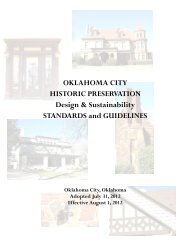OKC Plan, 2000-2020 - City of Oklahoma City
OKC Plan, 2000-2020 - City of Oklahoma City
OKC Plan, 2000-2020 - City of Oklahoma City
You also want an ePaper? Increase the reach of your titles
YUMPU automatically turns print PDFs into web optimized ePapers that Google loves.
Rural Area<br />
The Rural Area contains open country with very low intensity development. The<br />
predominant uses are agriculture, open space, and residential on large lots. These neighborhoods lie<br />
beyond the reach <strong>of</strong> most urban services for the next 20 years or more.<br />
Determining the suitable intensity for development is a key factor in planning for the Rural<br />
Area. This will include decisions as to appropriate density for residential development and the scale<br />
and character <strong>of</strong> commercial, industrial, and other non-residential development.<br />
There is no single standard for appropriate residential density, given the broad expanse <strong>of</strong> the<br />
Rural Area, varying levels <strong>of</strong> public services throughout the area, and wide differences in the scale<br />
and character <strong>of</strong> existing development. A near-urban density <strong>of</strong> one dwelling unit per acre may be<br />
appropriate where public services are generally available at close to urban area levels. In locations<br />
where public services are minimal to absent, the appropriate standard may be lots <strong>of</strong> five acres and<br />
larger. At locations with intermediate service levels, densities between one and five acres per<br />
dwelling unit may be appropriate. Factors to be considered in decisions regarding appropriate levels<br />
<strong>of</strong> development in the Rural Area are examined in the following sections.<br />
Compatibility with existing development. Rural residents and property owners have invested<br />
in their properties, in large part, because <strong>of</strong> a desire for “country living.” These existing property<br />
owners may view development proposals with smaller lot sizes than their own or with greater<br />
amounts <strong>of</strong> commercial uses as impacting their preferred rural lifestyle. However, compatibility<br />
should not be so strictly interpreted as to entirely preclude development, or force all development<br />
within an area to be within a very narrow range <strong>of</strong> lot sizes.<br />
Adequacy <strong>of</strong> services. Residential and commercial development replaces natural ground<br />
cover with impervious surfaces (streets, parking areas, and ro<strong>of</strong>tops) and increases the amount <strong>of</strong><br />
stormwater run-<strong>of</strong>f. The increased run-<strong>of</strong>f can overload area creeks and lead to downstream<br />
flooding. In addition, the time required for police and fire units to respond calls in outlying rural<br />
areas is generally greater than the response times in other areas <strong>of</strong> the <strong>City</strong>. As development<br />
increases in rural areas, some residents and property owners may request better police and fire<br />
protection. Meeting these requests would likely require increasing the number <strong>of</strong> police patrol units<br />
and the construction <strong>of</strong> new fire stations.<br />
Water quality and quantity. Water wells provide water supply for most <strong>of</strong> the Rural Area and<br />
sewage treatment is generally provided by septic tanks. Soil types and subsurface geology differ<br />
from location to location and this variability greatly impacts suitability for water wells and septic<br />
tanks. Tight soils in some areas can increase the size <strong>of</strong> drain fields required for suitable operation<br />
<strong>of</strong> septic tanks. Other areas may require alternative systems for sewage treatment. In other locations<br />
underground water may be nearly absent or severely limited with only a small number <strong>of</strong> suitable<br />
water well locations.<br />
12

















